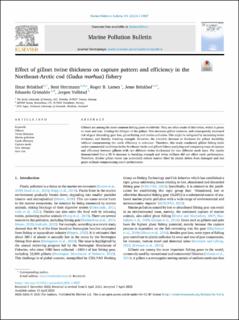| dc.contributor.author | Brinkhof, Ilmar | |
| dc.contributor.author | Herrmann, Bent | |
| dc.contributor.author | Larsen, Roger B. | |
| dc.contributor.author | Brinkhof, Jesse | |
| dc.contributor.author | Grimaldo, Eduardo | |
| dc.contributor.author | Vollstad, Jørgen | |
| dc.date.accessioned | 2023-08-10T13:52:39Z | |
| dc.date.available | 2023-08-10T13:52:39Z | |
| dc.date.created | 2023-06-26T14:19:05Z | |
| dc.date.issued | 2023 | |
| dc.identifier.citation | Marine Pollution Bulletin. 2023, 191 . | en_US |
| dc.identifier.issn | 0025-326X | |
| dc.identifier.uri | https://hdl.handle.net/11250/3083413 | |
| dc.description.abstract | Gillnets are among the most common fishing gears worldwide. They are often made of thin twine, which is prone to wear and tear, limiting the lifespan of the gillnet. This increases gillnet turnover, and consequently increased risk of gear discarding, gear loss, ghost fishing and marine pollution. This might be mitigated by increasing twine thickness, and thereby breaking strength. However, the tolerable increase in thickness for gillnet durability without compromising the catch efficiency is unknown. Therefore, this study conducted gillnet fishing trials under commercial conditions in the Northeast-Arctic cod gillnet fishery analysing and comparing ways of capture and efficiency between gillnets with two different twine thicknesses for two different mesh sizes. The results demonstrated that a 30 % increase in breaking strength and twine stiffness did not affect catch performance. Therefore, thicker gillnet twine can potentially reduce marine litter by plastic debris from damaged and lost gears without compromising catch performance. | en_US |
| dc.language.iso | eng | en_US |
| dc.publisher | Elsevier | en_US |
| dc.rights | Navngivelse 4.0 Internasjonal | * |
| dc.rights.uri | http://creativecommons.org/licenses/by/4.0/deed.no | * |
| dc.subject | Gillnets | en_US |
| dc.subject | Twine thickness | en_US |
| dc.subject | Marine pollution | en_US |
| dc.subject | Catch efficiency | en_US |
| dc.subject | Capture mode | en_US |
| dc.subject | Gear damage | en_US |
| dc.subject | Gear loss | en_US |
| dc.title | Effect of gillnet twine thickness on capture pattern and efficiency in the Northeast-Arctic cod (Gadus morhua) fishery | en_US |
| dc.title.alternative | Effect of gillnet twine thickness on capture pattern and efficiency in the Northeast-Arctic cod (Gadus morhua) fishery | en_US |
| dc.type | Journal article | en_US |
| dc.type | Peer reviewed | en_US |
| dc.description.version | publishedVersion | en_US |
| dc.rights.holder | © 2023 The Author(s). Published by Elsevier Ltd. This is an open access article under the CC BY license (http://creativecommons.org/licenses/by/4.0/). | en_US |
| dc.source.pagenumber | 0 | en_US |
| dc.source.volume | 191 | en_US |
| dc.source.journal | Marine Pollution Bulletin | en_US |
| dc.identifier.doi | 10.1016/j.marpolbul.2023.114927 | |
| dc.identifier.cristin | 2158129 | |
| cristin.ispublished | true | |
| cristin.fulltext | original | |
| cristin.qualitycode | 1 | |

